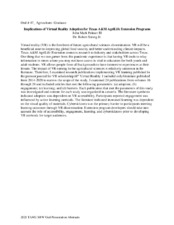| dc.creator | Palmer III, John Mark | |
| dc.creator | Strong Jr, Robert | |
| dc.date.accessioned | 2021-04-05T15:20:46Z | |
| dc.date.available | 2021-04-05T15:20:46Z | |
| dc.date.issued | 2021-03-30 | |
| dc.identifier.citation | Palmer III, J. M., & Strong Jr., R. (2021, March 30). Implications of Virtual Reality Adoption for Texas A&M AgriLife Extension Programs. [Oral] Virtual Presentation. Texas A&M University Student Research Week. | en |
| dc.identifier.uri | https://hdl.handle.net/1969.1/192664 | |
| dc.description.abstract | Virtual reality (VR) is the forefront of future agricultural sciences dissemination. VR will be a
beneficial asset to improving global food security and better understanding climate impacts.
Texas A&M AgriLife Extension connects research to industry and stakeholders across Texas.
One thing that we can garner from this pandemic experience is that having VR tools to relay
information in times where you may not have access is vital to education for both youth and
adult students. VR allows people from all backgrounds to have immersive experiences at their
leisure. The impact of VR earning in the agricultural sciences is relatively unknown in the
literature. Therefore, I examined research publications implementing VR learning published in
the premier journal for VR scholarship – Virtual Reality. I included only literature published
from 2014-2020 to narrow the scope of the study. I examined 24 publications from volumes 16
through 24 and included articles that met the following parameters: (a) adoption; (b)
engagement; (c) learning; and (d) barriers. Each publication that met the parameters of this study
was investigated and content for each study was organized in a matrix. The literature synthesis
indicated adoption was dependent on VR accessibility. Participants reported engagement was
influenced by active learning curricula. The literature indicated increased learning was dependent
on the visual quality of materials. Cybersickness was the primary barrier to participants meeting
learning outcomes through VR dissemination. Extension program developers should take into
account the role of accessibility, engagement, learning, and cybersickness prior to developing
VR curricula for target audiences. | en |
| dc.description.sponsorship | Aggie XR Laboratory | en |
| dc.language.iso | en_US | |
| dc.publisher | Texas A&M University Graduate and Professional Student Government | |
| dc.rights | CC0 1.0 Universal | en |
| dc.rights.uri | http://creativecommons.org/publicdomain/zero/1.0/ | |
| dc.subject | virtual reality, agricultural extension, systematic review | en |
| dc.title | Implications of Virtual Reality Adoption for Texas A&M AgriLife Extension Programs | en |
| dc.type | Presentation | en |
| local.department | Agricultural Leadership, Education, and Communications | en |



